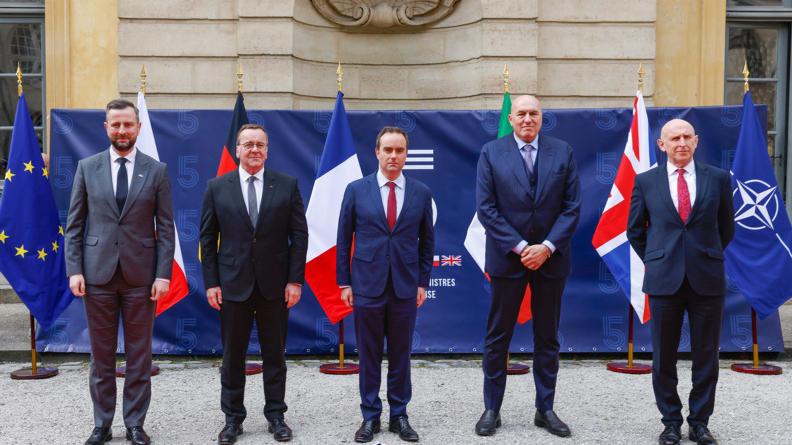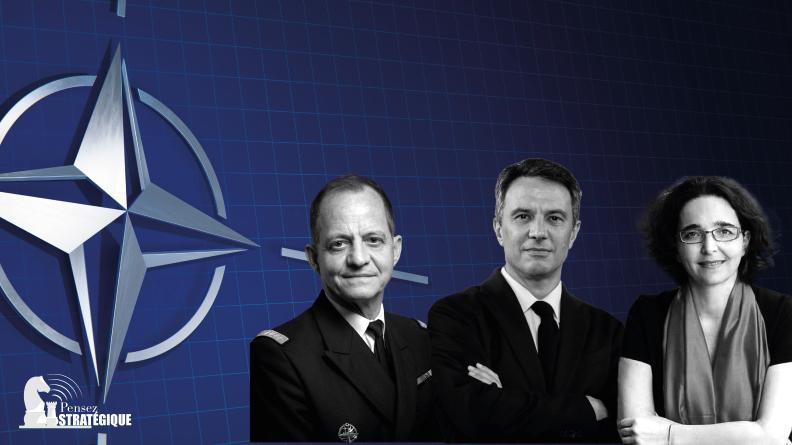[Podcast] 75 Years of NATO: The Transatlantic Relationship Standing the Test of Time [2/2]
The war in Ukraine has refocused the North Atlantic Treaty Organisation (NATO) on its primary mission: the collective defence of the European continent. With the return of high-intensity warfare on its doorstep, we look at the operational and political developments of the Alliance.
How is NATO strengthening its deterrent posture on Europe’s eastern flank? How does it ensure the interoperability of its 32 Members States? What does the future hold for the transatlantic relationship? Answers with presenter Daniel Desesquelle and his guests:
- Muriel Domenach, Ambassador, Permanent Representative for France on the North Atlantic Council
- Admiral Henri Schricke, French Military and Defence Representative to NATO and the European Union from 2020 to 2022
- Camille Grand, Former Assistant Secretary General of the North Atlantic Alliance from 2016 to 2022
Support for Ukraine
“NATO is not engaged in combat in Ukraine against Russia. However, it is acting to prevent the risk of escalation and avoid the conflict spilling over into neighbouring territories, including the Black Sea, which is bordered by Alliance member countries,” says Camille Grand. In practical terms, NATO is displaying its power by deploying a robust deterrent posture on Europe’s eastern flank. Eight battalions are deployed in Russian border states.
France is commanding one of these battalions in Romania through the Aigle mission, and is contributing to the reinforcement of another battalion in Estonia (Lynx mission). “We have more than 2,000 French soldiers deployed in total, with reinforcements depending on the activities we are involved in,” explains Admiral Schricke. “These operations demonstrate the solidarity between Europeans,” says Camille Grand, adding that “the support for Ukraine has come largely from EU Member States, particularly through training for Ukrainian soldiers.”
The Washington Summit, to be held from 9 to 11 July, should see support for Ukraine’s NATO membership reaffirmed. “We are unanimously in favour of Ukraine joining NATO,” says Muriel Domenach. However, while Ukraine is at war, “inviting it to join the alliance would make no sense. But we, the French, and many of our allies, note that Ukraine is on an irreversible pathway to NATO membership,” she adds.
[Podcast] 75 Years of NATO: The Transatlantic Relationship Standing the Test of Time [1/2]
Read the article32 Interoperable Armed Forces
NATO is also a huge technical challenge and one that is “far more complex than the D-Day Landings in 1944,” explains Admiral Schricke. Why? “Because there are not just three or four but 32 nations.” This cooperation between all the Alliance’s members was tested during the Steadfast Defender 24 exercise, which mobilised 90,000 soldiers from January to May 2024, making it the largest exercise organised for decades. “But we should look beyond the figures,” says the Admiral, “otherwise the exercise is seen only in terms of troops.” There are indeed many factors to take into account in this kind of training: the credibility of operational plans, the coordination of movements, the understanding between each member, the decision-making process, etc. “It’s a real challenge because it involves 32 different cultures and 32 different political contexts,” notes Admiral Henri Schricke.
Rebalancing in progress
The question of the United States’ place in NATO has often been raised, particularly in view of its substantial investment in defence, “which exceeds that of its European allies by one or two percentage points of GDP,” according to Camille Grand. But the United States’ ‘pivot to Asia’ initiated by President Barack Obama in 2014, is changing the American Ally’s order of priorities and placing the Indo-Pacific at the top of the list. “The priority given to the Chinese threat is very clear, both in American defence investment and their strategic priorities,” says the former Assistant Secretary General. “And the war in Ukraine has only changed this partially.” To his mind, the figures speak for themselves: “During the Cold War, there were up to 430,000 American soldiers in Europe, compared with 100,000 today during major exercises (...) While this presence is significant, it does not make it the backbone of NATO’s armed forces in Europe.”
This pivot is leading to a “cultural revolution among the Allies,” says Camille Grand. In his view, “these debates should encourage Europeans to reinforce their ability to respond to crises without relying on the American Ally as not only the ultimate but also the immediate guarantee of security.” This awareness also requires Europeans to invest in their own defence, known as the ‘burden sharing’ called for by Washington. “Until 2014 and Russia’s annexation of Crimea, only three countries invested 2% of their GDP in NATO. Today, we have reached 23 out of 32, which is real progress,” says Camille Grand. “The latest figures show that Europeans are now investing €100 billion more in NATO each year than in 2014.”
To Muriel Domenach, the Washington Summit will be an important event for the Alliance. “Since Donald Trump’s first presidency, the Americans have perhaps been less predictable than before, and they have been facing a considerable military and geopolitical challenge in Asia for a long time. [...] In any event, we must take greater responsibility and strengthen our European sovereignty, in the general interest,” she adds.
Featured
Ukraine: E5 defence ministers reassert their support
As the conflict in Ukraine continues, the defence ministers of the E5 group (France, Germany, Poland, Italy...
March 14, 2025

NATO Ambassadors Visit Istres Air Force Base
On 6 March 2025, the ambassadors from the NATO (North Atlantic Treaty Organisation) Allies visited the Istr...
March 10, 2025

[Podcast] 75 Years of NATO: The Transatlantic Relationship Standing the Test of Time [1/2]
On 4 April, the North Atlantic Treaty Organisation (NATO) celebrated its 75th anniversary. A cel...
July 11, 2024
